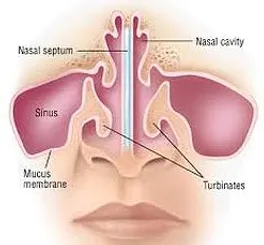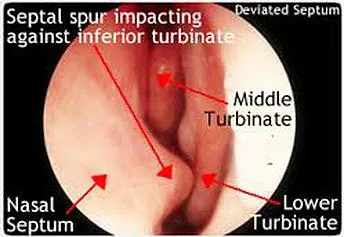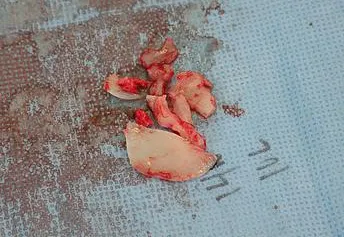Nasal Septal Spurs
DEVIATED SEPTUM
The structure of the internal and external parts of the nose can have a profound impact on breathing. A deviated septum, for example, can make breathing through the nose difficult. In addition to deviations of the septum, there are other issues which may contribute to problems breathing through the nostrils, such as enlarged turbinates and cartilage or bone spurs.
NASAL SEPTUM
The nasal septum is made of cartilage and is located in the very center of the nose. It is the structure that separates the right nostril airway from the left nostril airway. Deviations of the septum can block the flow of air in the nostrils and interfere with breathing.
A deviated septum can be corrected by removing the curved portions of the septum and by perfoming a septo-plasty (reshaping of the septum) at the same time. The exact areas that need to be removed, and the specific techniques used to re-shape the septum, will vary from person to person. These techniques may involve moving the septum to the midline and applying a combination of stitches to modify the curvature of the septum.

Normal internal anatomy of the nose showing the nasal septum, inferior (lower) nasal turbinates and the nasal sinuses.

Removal of curved portions of the septum combined with reshaping of the septum (septo-plasty).
INFERIOR NASAL TURBINATES
The inferior nasal turbinates are small growths of bone covered with a mucosa lining (the lining of the inside of the nose) located within the nostril airway. The purpose of the inferior nasal turbinates is to warm and humidify the air coming through the nostrils.
In some patients, the inferior nasal turbinates can be enlarged. This enlargement causes the tubinate to block the nostril airway, making breathing more difficult. In some severe cases, the septum and the turbinates may touch, completely blocking all air flow.
In order to correct this, the turbinates must be reduced in size. This can be done by removing or moving the small portion of bone inside the turbinate. (see the diagram to the right). Once this is done, the airway will become more open.

The bone of the inferior turbinate can be removed or reduced in order to open the nostril airway.
CARTILAGE AND BONE SPURS
Spurs are small outgrowths of cartilage or bone inside the nose. Spurs are often found along the bottom of the septum where they may interfere with breathing. They vary in size, but can become quite large.
When this occurs, it will be necessary to remove the spurs in combination with other techniques to improve nasal breathing.

The picture above is of the inside of the left nostril. In this example, there is a spur from the nasal septum going into the left nostril airway. It is large enough to touch the lower (inferior) turbinate located across from it. This severely reduces airflow and needs to be corrected.
Combination of Septal Deviation, Lower Turbinate Enlargement and Bony Spurs
More often than not, breathing difficulties through the nose are usually caused by a combination of multiple issues. These include septal deviation, enlarged lower turbinates and the presence of bony spurs.
In these cases, it will be necessary to surgically correct all problems. The combination of removal of portions of curved septum, septoplasty (septum reshaping), lower turbinate reduction and removal of bony spurs will be necessary. When this is done, the improvement in breathing can be dramatic.

This is from an actual patient. The line points to the portion of the septum that was deviated and was removed. The surrounding fragments (circled) are composed of the inferior turbinate bones, cartilage spurs and bone spurs which were interfering with breathing. Some patients have a large amount of bone and cartilage blocking their airway, as you can see in this photo.
This is a video which shows how Dr. John Diaz performs his technique for removing portions of the septum which are deviated. His technique is done using a “Closed” approach which means that all incisions are made inside the nostrils. There are no external or visible scars with this technique.
Allergan Diamond Status
Top 3% Of Plastic Surgeons In The Nation.
Google / Yelp / RealSelf
4.9 Star Rating / 515 Reviews
Highest Antibacterial Standards
One of the lowest rates of infection after surgery in the world.
1,000s Of Surgerys
One of the lowest rates of infection after surgery in the world.
Alpha Omega Alpha Award
Top 10% Of Medical Students In The Nation
About Dr. John Diaz
Dr. John Diaz is an Ivy League graduate from Cornell University. He received a scholarship to attend the prestigious Albert Einstein College of Medicine in New York. Dr. Diaz graduated medical school with the highest honors and for this he received the Alpha Omega Alpha Award, which is given to only the top 10% of medical students in the country.
He completed his training in Plastic and Reconstructive Surgery in N.Y.C. where he had the privilege of working alongside some of the most famous plastic surgeons in the world. Dr. Diaz is a published author of articles on plastic surgery. He received a degree with Distinction in Plastic Surgery Research for his work.
He has received awards from the New York Regional Society of Plastic Surgery, Montefiore Medical Center and the Albert Einstein College of Medicine. Dr. Diaz is a medical staff member of the renowned Cedars Sinai Medical Center in Los Angeles, CA and has a private practice in Beverly Hills. He is the Past President of the Los Angeles Society of Plastic Surgeons and has presented lectures on plastic surgery throughout the United States.
He has been featured as a plastic surgery expert on a variety of television programs including CNN, Dr. Drew’s Lifechangers, and HLN, to name a few.
Dr. John Diaz is a board certified plastic surgeon in Beverly Hills, CA
![]()
![]()
![]()



![]()

PATIENT REVIEWS
ALMOST 20 YEARS OF EXPERIENCE. THOUSANDS OF HAPPY PATIENTS.
HUNDREDS OF FIVE STAR REVIEWS.
HIGHEST OVERALL RATED PLASTIC SURGEON IN LOS ANGELES
Media
DR. JOHN DIAZ IS ONE OF THE TOP PLASTIC SURGEONS IN LOS ANGELES.

LA Magazine just recognized Dr. John Diaz as one of the best plastic surgeons in Beverly Hills and Los Angeles. He has also published a book entitled Comprehensive Guide to Breast Augmentation.
DR. DIAZ ON INSTAGRAM

